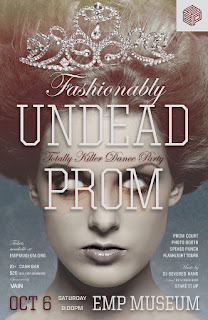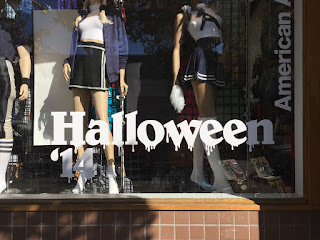Evaluation
This project helped me to develop both my photo taking skills and my Adobe Illustrator skills. I feel as though my best work was from when I had to take photographs in an urban environment whilst using the Rule of Thirds to create a more interesting composition, as it allowed me to be creative in finding subject matter for my photographs whilst still working under a theme. I struggled with taking photos of Urban Juxtaposition as I had a limited time frame, and it was very difficult to find subject matter that really captured the idea of juxtaposition in an urban environment. I found that the work based on different types of font-faces and analysing where and why they are used in the real world was very interesting, and helped me to create a better final piece. I also enjoyed learning about photo composition and The Rule of Thirds, as it will help me to take better Photographs in the future.
My Final Piece:
For this unit of work, I was asked to create a poster, using one or more of my own images for a Photography exhibition based around Urban Juxtaposition in an Art Gallery. This is my final poster design for this project, influenced by my thumb nail sketches.
I chose to use this particular image for my poster because I think that it shows an excellent example of Urban Juxtaposition, which gives you a better idea of what the exhibition is going to be about. This is because you don't usually expect to see plants and other forms of nature growing so well and freely in such an urban environment surrounded by steel and concrete. The image I used also works well as part of a poster due to the colours and composition. The bold, bright flower stands out really well against the darker and colder colours of the large building behind it, which easily catches the eye of the viewer. The fact that the flower in the foreground of the photograph is so central, as I used the Rule of Thirds, also helps to catch the eye of the viewer. I decided to keep the White text against a Black background so that it stands out well, and is easy to read. If I had decided to write the text directly over the photograph it might have been difficult to read because of the different colours and tones in the image. I decided to keep the description in the black box a-long with the rest of the infomation that you would have to read. I originally tired it in the top left corner of the poster on the image in a Black font, but I felt that there was too much of an empty gap at the bottom of the poster in the Black box. I added a thin Black border around the edge of the Photograph in order to make the Black text bar at the bottom look more like it belonged there, and to make the overall poster pop, and so that it would stand out well against whatever surface the poster is put on. I knew that I wanted to make the main title stand out well, so I used a large Font size and decided to place it in the centre of the image. The problem I had with this was that I couldn't find a colour that stood out well across the whole photograph. To fix this I decided to use Photoshop to create a clipping mask with the text I wanted over the image, so that the text was fully see-through inside a slightly transparent box.
If I was to do this project again, when taking my Urban Juxtaposition photographs and Urban photographs using the Rule of Thirds, I would ensure that I went into more than one town, and maybe visit a large city so that I would have a wider variety of subject matter to photograph. I'd like to take photos like this again in a large city as I would have lots of challenges and obstacles such as people getting in the way, and light being blocked my buildings. Larger buildings in large city centres may also make for a more interesting composition.
My Final Piece:
For this unit of work, I was asked to create a poster, using one or more of my own images for a Photography exhibition based around Urban Juxtaposition in an Art Gallery. This is my final poster design for this project, influenced by my thumb nail sketches.
I chose to use this particular image for my poster because I think that it shows an excellent example of Urban Juxtaposition, which gives you a better idea of what the exhibition is going to be about. This is because you don't usually expect to see plants and other forms of nature growing so well and freely in such an urban environment surrounded by steel and concrete. The image I used also works well as part of a poster due to the colours and composition. The bold, bright flower stands out really well against the darker and colder colours of the large building behind it, which easily catches the eye of the viewer. The fact that the flower in the foreground of the photograph is so central, as I used the Rule of Thirds, also helps to catch the eye of the viewer. I decided to keep the White text against a Black background so that it stands out well, and is easy to read. If I had decided to write the text directly over the photograph it might have been difficult to read because of the different colours and tones in the image. I decided to keep the description in the black box a-long with the rest of the infomation that you would have to read. I originally tired it in the top left corner of the poster on the image in a Black font, but I felt that there was too much of an empty gap at the bottom of the poster in the Black box. I added a thin Black border around the edge of the Photograph in order to make the Black text bar at the bottom look more like it belonged there, and to make the overall poster pop, and so that it would stand out well against whatever surface the poster is put on. I knew that I wanted to make the main title stand out well, so I used a large Font size and decided to place it in the centre of the image. The problem I had with this was that I couldn't find a colour that stood out well across the whole photograph. To fix this I decided to use Photoshop to create a clipping mask with the text I wanted over the image, so that the text was fully see-through inside a slightly transparent box.
If I was to do this project again, when taking my Urban Juxtaposition photographs and Urban photographs using the Rule of Thirds, I would ensure that I went into more than one town, and maybe visit a large city so that I would have a wider variety of subject matter to photograph. I'd like to take photos like this again in a large city as I would have lots of challenges and obstacles such as people getting in the way, and light being blocked my buildings. Larger buildings in large city centres may also make for a more interesting composition.
































































